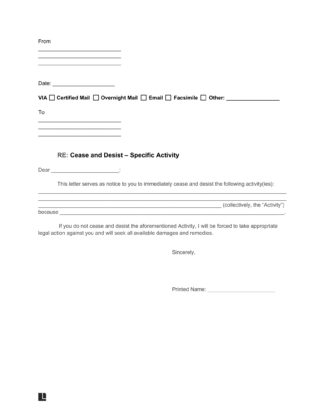
Inform people or businesses harassing you (or infringing on your rights) that you’ll take legal action unless they stop.

Updated September 5, 2024
Written by Sara Hostelley | Reviewed by Brooke Davis
A cease and desist letter aims to resolve a dispute outside of court. It formally requests that an individual or business halt actions infringing on your rights, such as illegal activities or harassment, and continue to refrain from unwanted behavior.
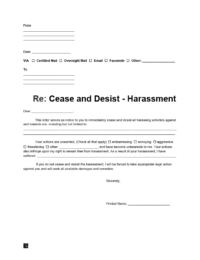
Use a Harassment Cease and Desist If you’re receiving persistent personal or sexual harassment, unwanted treatment, or being threatened. (Skip ahead if debt collectors are harassing you.)
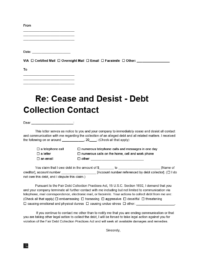
If a debt collection agency is overwhelming you with excessive phone calls, use a Debt Collection Cease and Desist to demand that they stop.
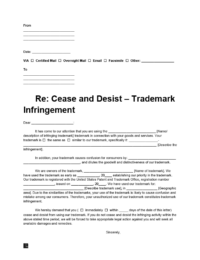
If another person or business is infringing on your trademark, use a Trademark Infringement Cease and Desist to explain why it’s confusing for customers and demand that they stop using it.
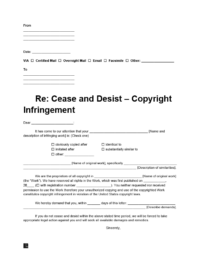
If someone blatantly copies, steals, or imitates your original work or website, use a Copyright Infringement Cease and Desist to demand that they provide proper credit or stop immediately.
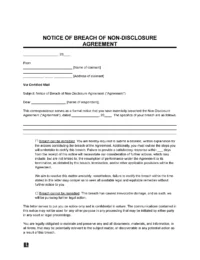
If someone is sharing confidential information about you or your business after signing an NDA, use an NDA Violation Cease and Desist to demand they stop such actions.
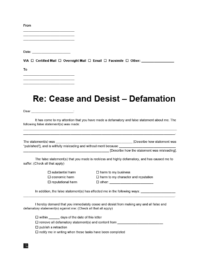
If someone is slandering or libelling you or your business, use a Defamation Cease and Desist to demand that they stop making such claims.
A cease and desist letter (or demand letter) is a written communication that informs another party they’re engaging in behavior that violates your legal rights. It demands the recipient immediately stop the specified infringing actions and refrain from repeating them in the future.
This document is not legally enforceable and does not have any legal authority. However, it acts as a warning and can effectively communicate your grievances and the potential legal consequences if the violating party doesn’t comply.
In many cases, a cease and desist letter may be all it takes to prevent further infringement of your rights. The threat of legal action is often sufficient to avoid any other controversy. However, a lawsuit may be necessary if the letter fails to accomplish its intended goal.
Here are six instances when using a cease and desist letter can help you stop an individual or business from infringing on your rights:
Use this letter to stop others from using your company’s patents, copyrights, and trademarks without permission. It can also demand the removal of any published materials featuring your intellectual property.
If someone has unlawfully used your intellectual property and you seek compensation for the damages incurred, you may send a demand for payment letter to accompany your cease and desist letter to demand reparations for the infringement.
Send a cease and desist letter to stop various forms of harassment, such as discriminatory treatment, unwanted advances, verbal abuse, cyberbullying, stalking, and intimidation. This communication can prompt the perpetrator to cease their harmful behavior, as the threat of legal action may be enough to curb their previous actions.
Protect your reputation from further damage by sending a cease and desist letter to stop libel (written defamation) or slander (oral defamation). This letter alerts the perpetrator to the impact of their statements, negative reviews, or gossip and requests that they stop spreading false information.
If the violating party doesn’t heed your warnings, you may need to proceed with filing a defamation lawsuit.
For example, A small business owner in a local community discovered that a former employee was spreading false rumors about the business online and in person. The ex-employee had posted several negative reviews on various social media platforms and local review sites, accusing the business of unethical practices, which were entirely untrue. The false statements began to damage the business’s reputation, leading to a decline in customers and revenue.
In response, the business owner decided to take action by sending a cease and desist letter to the former employee. The letter outlined the defamatory nature of the statements, explained the harm these false claims were causing, and demanded that the ex-employee immediately stop making and spreading these false allegations. The letter also warned that if the defamatory conduct continued, the business owner would pursue legal action, including a defamation lawsuit, to protect the business’s reputation.
After receiving the cease and desist letter, the former employee ceased their defamatory activities, and the negative reviews were removed. The situation was resolved without the need for further legal action, and the business was able to restore its reputation in the community.
If someone violates a contract, use this letter to demand compliance with the contract’s terms and give them a chance to rectify the situation.
For example, suppose you have a contract with a freelancer that requires them to keep information confidential. If they breach the contract and divulge the information to unauthorized parties, you can issue a cease and desist letter to let them correct their behavior. Depending on the situation, you may need to follow additional steps to handle a confidentiality breach.
Assert your property rights as the legal owner and stop encroachment or trespassing with a cease and desist letter. It can serve as evidence if the issue goes to court.
Before taking action, confirm your understanding of your property lines. Review your property deed and any existing survey documents to determine whether your neighbors or others are actually encroaching or trespassing.
If debt collectors harass you, use this letter to demand they stop unlawful practices outlined in the Fair Debt Collection Practices Act (FDCPA). Failure to comply may result in legal action and penalties against the debt collection agency.
If a debt collector is engaging in any of the following behaviors with you, you may have grounds to send them this letter:
Assess your situation to determine if sending a cease and desist letter is appropriate. Consider whether the offending party’s misconduct is causing harm or violating your rights in a way that justifies further intervention.
If other attempts, such as verbal conversations with the violator, haven’t been successful, you may resort to sending a letter to communicate your need for the behavior to stop.
Once you determine sending a cease and desist letter is the right course of action, you can start dating it. Develop an outline by considering these essential elements:
Include a direct statement specifying what will happen if the recipient doesn’t comply. For example, you can include the following phrase: If you do not cease and desist the aforementioned activity, I will be forced to take appropriate legal action against you and will seek all available damages and remedies.
Compile supporting evidence and documentation that proves the misconduct. For example, suppose your business is a victim of trademark infringement. In this case, you can list where the violator is using your trademark without consent and provide your trademark registration number as proof of your business’s legal claim to the symbol or design.
Tailor the evidence you provide to your situation. For example, videos, audio recordings, or screenshots of text messages can show an individual’s misconduct if you’re sending a cease and desist letter for harassment.
Once you review and finalize your letter, send it to the recipient via certified mail. This option provides proof of delivery and confirms the offending party’s receipt of the document.
The return receipt service costs $4.40 through USPS, and you can expect to pay other delivery fees depending on the letter’s size and whether you include supporting documentation. If you don’t send the document through USPS, you can use OnlineCertifiedMail.com to send your letter for just $9.69.
DON’T use FedEx or UPS because in Leatherbury v. Greenspun, 939 A.2d 1284 (Del. 2007), the Supreme Court of Delaware held that private carriers couldn’t replace Certified Mail with a return receipt sent via USPS.
No matter how you send it, keep a copy of the document and the return receipt. Proper documentation of the letter you send and any receipt information may be critical in future legal disputes if necessary.
If you gave the offending party a deadline to respond or end their misconduct, wait until this time passes before taking further action. Ultimately, how long you should wait depends on your circumstances and what you must do to protect your legal rights.
Negotiations with the other party may be possible if you receive a favorable response to your letter. However, if you get an unfavorable response or the offending party ignores your letter, it is likely time to take the legal action originally alluded to.
If the recipient agrees to stop the infringing activity but wants protection from further legal action regarding their past transgressions, you may include a release of liability waiver in the settlement agreement to formalize the resolution and absolve them from future liability.
It’s often best to follow through with any legal repercussions in your letter to show you’re serious about protecting your rights. You may want to consult an attorney and seek their advice on proceeding.
Download a free cease and desist letter template in PDF or MS Word format below: